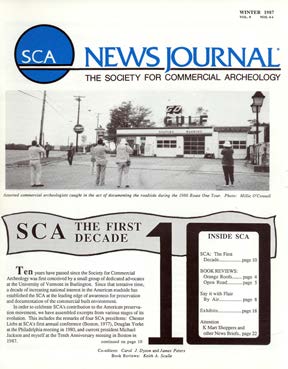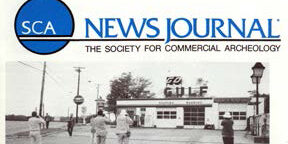By Arthur Krim
 FORTY YEARS AGO in November 1977, the first annual meeting of the Society for Commercial Archeology (SCA) took place at the Museum of Transportation in Boston, now the site of the Children’s Museum on the Fort Point Channel. Various papers were presented with carousel slideshows, on Popular Landmarks of Route One in Saugus, Mass., the Art Deco Bridges of the Merritt Parkway in Connecticut, and other subjects of SCA interest.
FORTY YEARS AGO in November 1977, the first annual meeting of the Society for Commercial Archeology (SCA) took place at the Museum of Transportation in Boston, now the site of the Children’s Museum on the Fort Point Channel. Various papers were presented with carousel slideshows, on Popular Landmarks of Route One in Saugus, Mass., the Art Deco Bridges of the Merritt Parkway in Connecticut, and other subjects of SCA interest.
The museum was selected in part for its giant Hood Milk Bottle, preserved and relocated from Taunton, Mass., by early member Carol Scholfield in 1976. It was the first large commercial object in New England to receive such notoriety and marked the beginning of postwar professional recognition of historic American roadside landmarks from the 20th century.
The first Boston meeting was preceded by a year of planning that had its origins at an announced gathering of planners, artists, architects, and historians at the University of Vermont (UVM) in Burlington. It was organized in
November 1976 under the direction of Chester Liebs of the Preservation Program at UVM for a conference titled “Commercial Archeology” of American Roadside History, modeled after the existing Society for Industrial Archaeology, itself based on British prototypes.
Among those gathered were noted artists John Baeder, famous for his diner paintings; Steve Izenour, from the architectural firm of Venturi and Rauch in Philadelphia; Dan Scully, innovative architect from Harrisville, N.H.; Douglas Yorke from New Jersey; Kathlyn Hatch, architectural historian from Cambridge; Lynn Spencer from Society for the Preservation of New England Antiquities (SPNEA); and myself working for the Cambridge Historical Commission on 20th century architecture.
 It was this core group that gathered in early 1977 in Harrisville, N.H., to formalize the organization of the “Society for Commercial Archeology” in its modern spelling with the “SCA” logo designed by John Baeder, Steve Izenour and Doug Yorke that still trademarks the Society’s publications.
It was this core group that gathered in early 1977 in Harrisville, N.H., to formalize the organization of the “Society for Commercial Archeology” in its modern spelling with the “SCA” logo designed by John Baeder, Steve Izenour and Doug Yorke that still trademarks the Society’s publications.
Further discussions were held at the SPNEA’s Codman House in Lincoln, Mass., to work out a mission statement and organizational details. The group was brought together with common interests in American Roadside History, including New England diners, highway gas stations, and neon signs in the Boston area. Early advocates were Millie O’Connell, John Axtell, Peter Smith, John Dugger, Peter Richards, and Miriam Trementozi.
Over the summer of 1977, the formative group of the SCA envisioned a larger organization with publications, guidebook tours, and annual meetings beyond the New England core with Chester Liebs as the president.
With the first Boston meeting in November 1977, the SCA took on the publication of the SCA News Journal in the Fall of 1978, with articles on the Kitchenette Diner in Cambridge, Mass., Coca-Cola sign in Boston, and Howard Johnson’s under the editorship of Kathy Hatch. The SCA received local publicity on Boston PBS channel WGBH in January 1979 for the Coca-Cola sign preservation effort led by Kathy Hatch and myself.
A major success in 1980 was the “All Night, All Night Diner Tour” of Boston and Providence led by Millie O’Connell, John Axtell, and Doug Yorke.
 Early SCA meetings were held at Columbia University in New York, at the Venturi and Rauch offices in Manyunk, Pa., and at the National Trust in Washington under the hospitality of Susan Shearer. In the meantime, individual members advocated for unique preservation efforts, including Mammy’s in Vicksburg, Miss., by Doug Yorke; the Kitchenette Diner in Cambridge, Mass., by Millie O’Connell; and my own effort with the Coca-Cola and CITGO signs in Boston that received national publicity by 1982.
Early SCA meetings were held at Columbia University in New York, at the Venturi and Rauch offices in Manyunk, Pa., and at the National Trust in Washington under the hospitality of Susan Shearer. In the meantime, individual members advocated for unique preservation efforts, including Mammy’s in Vicksburg, Miss., by Doug Yorke; the Kitchenette Diner in Cambridge, Mass., by Millie O’Connell; and my own effort with the Coca-Cola and CITGO signs in Boston that received national publicity by 1982.
All these activities, with the annual meetings, tour guides, and the publication of the SCA News Journal brought stability and recognition to the Society. By the 10th annual meeting in Detroit at the Henry Ford Museum in 1988, the SCA had realized its original goal as a national organization beyond its local New England roots and membership.
Four decades have passed all too quickly and have established that the 20th-century American popular highway culture has left a unique legacy on the landscape worthy of appreciation, preservation, and serious study into our 21st century.
Arthur Krim is a founding member and past president of the SCA.
This article originally appeared in the SCA Journal, Spring 2017, Vol. 35, No. 1. The SCA Journal is a semi-annual publication and a member benefit of the Society for Commercial Archeology.


